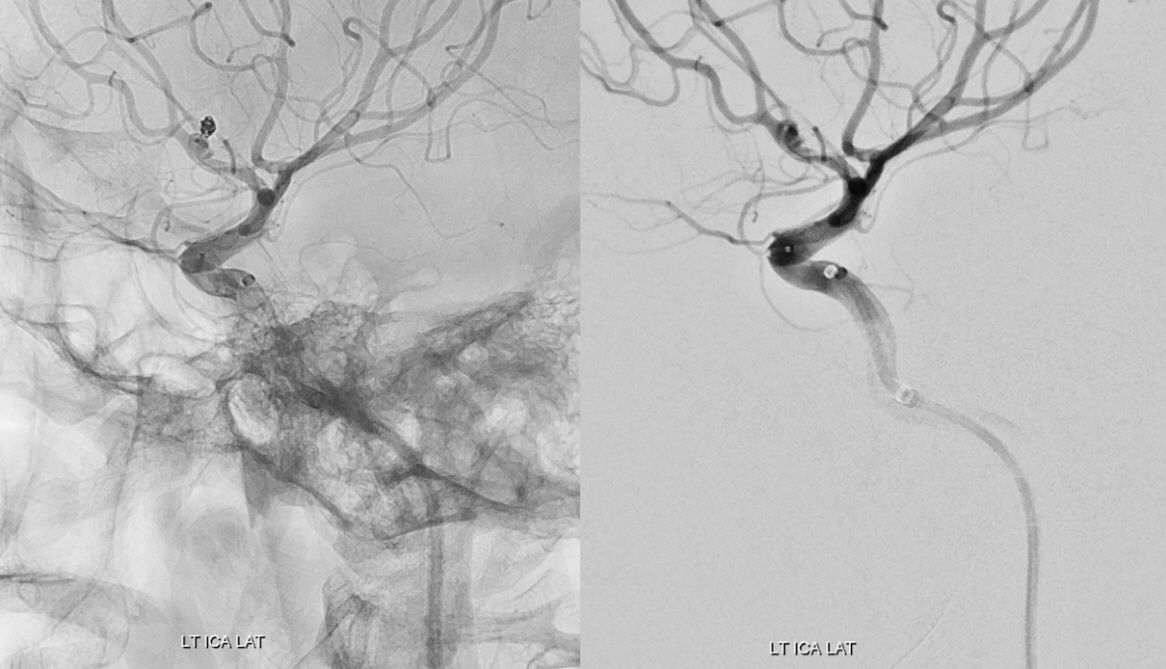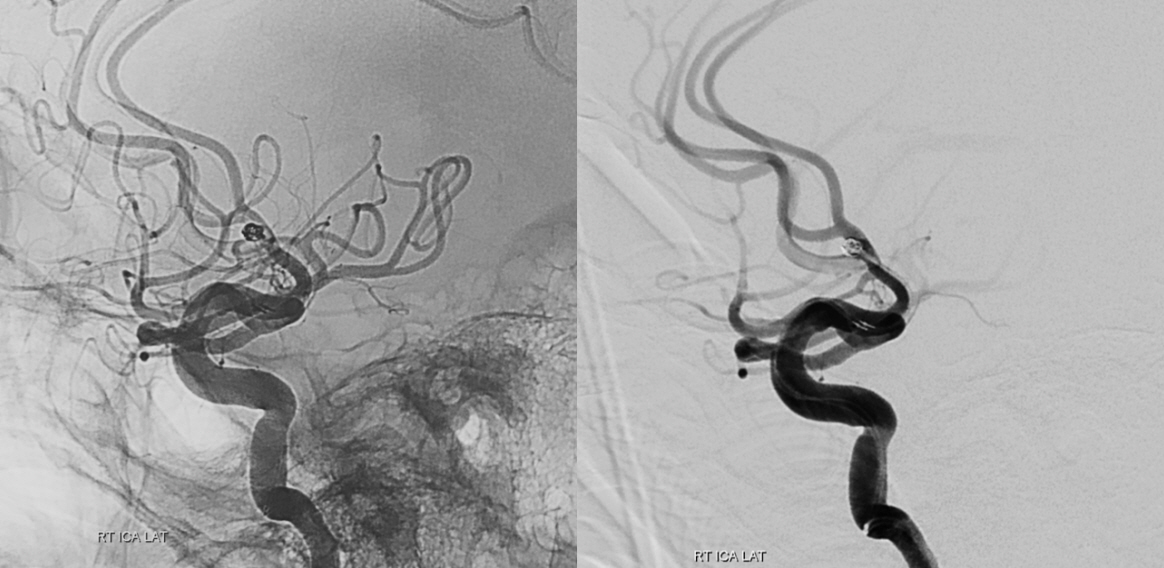J Cerebrovasc Endovasc Neurosurg.
2024 Jun;26(2):141-151. 10.7461/jcen.2023.E2023.08.002.
The safety and efficacy of double microcatheter technique in small and tiny ruptured aneurysms: A single center study
- Affiliations
-
- 1Department of Neurosurgery, Inje University, Ilsan Paik Hospital, Goyang, Korea
- KMID: 2556976
- DOI: http://doi.org/10.7461/jcen.2023.E2023.08.002
Abstract
Objective
Double microcatheter technique (dMC) can be the alternative to Single microcatheter technique (sMC) for challenging cases, but there is lack of studies comparing dMC to sMC especifically for small ruptured aneurysms. Our objective was to compare the safety and efficacy of dMC to sMC in treating small (≤5 mm) and tiny (≤3 mm) ruptured aneurysms.
Methods
This study focused on 91 out of 280 patients who had ruptured aneurysms and underwent either single or double microcatheter coil embolization. These patients were treated with either single or double microcatheter coil embolization. We divided the patients into two groups based on the procedural method and evaluated clinical features and outcomes. Subgroup analyses were conducted specifically for tiny aneurysms, comparing the two methods, and within the dMC group, we also examined whether the aneurysm was tiny or not. In addition, univariate logistic regression analysis was performed to assess the impact of coil packing density.
Results
The mean values for most outcome measures in the dMC group were higher than those in the sMC group, but these differences did not reach statistical significance (coil packing density, 45.739% vs. 39.943%; procedural complication, 4.17% vs. 11.94%; recanalization, 8.3% vs. 10.45%; discharge discharge modified Rankin Scale (mRS), 1.83 vs. 1.97). The comparison between tiny aneurysms and other sizes within the dMC group did not reveal any significant differences in terms of worse outcomes or increased risk. The only factor that significantly influenced coil packing density in the univariate logistic regression analysis was the size of the aneurysm (OR 0.309, 95% CI 0.169–0.566, p=0.000).
Conclusions
The dMC proved to be a safe and viable alternative to the sMC for treating small ruptured aneurysms in challenging cases.
Keyword
Figure
Reference
-
1. Akgul E, Aksungur E, Balli T, Onan B, Yilmaz D, Bicakci S, et al. Y-stent-assisted coil embolization of wide-neck intracranial aneurysms: A single center experience. Interv Neuroradiol. 2011; Mar. 17(1):36–48.
Article2. Baxter BW, Rosso D, Lownie SP. double microcatheter technique for detachable coil treatment of large, wide-necked intracranial aneurysms. AJNR Am J Neuroradiol. 1998; JunJul. 19(6):1176–8.3. Bechan RS, Sprengers ME, Majoie CB, Peluso JP, Sluzewski M, van Rooij WJ. Stent-assisted coil embolization of intracranial aneurysms: Complications in acutely ruptured versus unruptured aneurysms. AJNR Am J Neuroradiol. 2016; Mar. 37(3):502–7.
Article4. Bodily K, Cloft H, Lanzino G, Fiorella D, White P, Kallmes DF. Stent-assisted coiling in acutely ruptured intracranial aneurysms: A qualitative, systematic review of the literature. AJNR Am J Neuroradiol. 2011; Aug. 32(7):1232–6.
Article5. Brinjikji W, Lanzino G, Cloft HJ, Rabinstein A, Kallmes DF. Endovascular treatment of very small (3 mm or smaller) Intracranial aneurysms: Report of a consecutive series and a meta-analysis. Stroke. 2010; Jan. 41(1):116–21.
Article6. Chen Z, Feng H, Tang W, Liu Z, Miao H, Zhu G. Endovascular treatment of very small intracranial aneurysms. Surgical Neurology. 2008; Jul. 70(1):30–5.
Article7. Geraghty S, Kreitel KD, Medel R, et al. Single-center experience with a dual microcatheter technique for the endovascular treatment of wide-necked aneurysms. J Neurosurg. 2014; Nov. 121(5):1093–101.
Article8. Goddard JK, Moran CJ, Cross DT 3rd, Derdeyn CP. Absent relationship between the coil-embolization ratio in small aneurysms treated with a single detachable coil and outcomes. AJNR Am J Neuroradiol. 2005; Sep. 26(8):1916–20.9. Golshani K, Ferrel A, Lessne M, Shah P, Chowdhary A, Choulakian A, et al. Stent-assisted coil emboilization of ruptured intracranial aneurysms: A retrospective multicenter review. Surg Neurol Int. 2012; 3:84.
Article10. Hassankhani A, Ghozy S, Bilgin C, Kadirvel R, Kallmes DF. Packing density and the angiographic results of coil embolization of intracranial aneurysms: A systematic review and meta-analysis. Interv Neuroradiol. 2023; Feb. 15910199231155288.
Article11. Kim DJ, Kim BM, Park KY, Ihm EH, Baek JH, et al. Coil embolization of overwide and undertall small intracranial aneurysms with double microcatheter technique. Acta Neurochir (Wien). 2014; May. 156(5):839–46.
Article12. Kühn AL, Hou SY, Puri AS, Silva CF, Gounis MJ, Wakhloo AK. Stent-assisted coil embolization of aneurysms with small parent vessels: safety and efficacy analysis. J Neurointerv Surg. 2016; Jun. 8(6):581–5.
Article13. Kwon OK, Kim SH, Kwon BJ, Kang HS, Kim JH, Oh CW, et al. Endovascular treatment of wide necked aneurysms by using two microcatheters: Techniques and outcomes in 25 patients. AJNR Am J Neuroradiol. 2005; Apr. 26(4):894–900.14. Lee YJ, Kim DJ, Suh SH, Lee SK, Kim J, Kim DI. Stent-assisted coil embolization of intracranial wide-necked aneurysms. Neuroradiology. 2005; Sep. 47(9):680–9.
Article15. Mascitelli JR, Moyle H, Oermann EK, Polykarpou MF, Patel AA, Doshi AH, et al. An update to the Raymond–Roy Occlusion Classification of intracranial aneurysms treated with coil embolization. J Neurointerv Surg. 2015; Jul. 7(7):496–502.
Article16. Molyneux A, Kerr R, Stratton I, Sandercock P, Clarke M, Shrimpton J, et al. International subarachnoid aneurysm trial (ISAT) of neurosurgical clipping versus endovascular coiling in 2143 patients with ruptured intracranial aneurysms: A randomised trial. Lancet. 2002; Oct. 360(9342):1267–74.
Article17. Neifert SN, Chapman EK, Martini ML, Shuman WH, Schupper AJ, Oermann EK, et al. Aneurysmal subarachnoid hemorrhage: The last decade. Transl Stroke Res. 2021; Jun. 12(3):428–46.
Article18. Nguyen TN, Raymond J, Guilbert F, Roy D, Bérubé MD, Mahmoud M, et al. Association of endovascular therapy of very small ruptured aneurysms with higher rates of procedure-related rupture. J Neurosurg. 2008; Jun. 108(6):1088–92.
Article19. Rinaldo L, Lanzino G. Increased age associated with reduced likelihood of recurrence after coiling of ruptured aneurysms. World Neurosurg. 2017; Apr. 100:381–7.
Article20. Schirmer CM, Hoit DA, Malek AM. Decompressive hemicraniectomy for the treatment of intractable intracranial hypertension after aneurysmal subarachnoid hemorrhage. Stroke. 2007; Mar. 38(3):987–92.
Article21. Schuss P, Borger V, Vatter H, Singer OC, Seifert V, Güresir E. Antiplatelet therapy, but not intravenous thrombolytic therapy, is associated with postoperative bleeding complications after decompressive craniectomy for stroke. J Neurol. 2013; Aug. 260(8):2149–55.
Article22. Sluzewski M, Bosch JA, van Rooij WJ, Nijssen PCG, Wijnalda D. Rupture of intracranial aneurysms during treatment with Guglielmi detachable coils: Incidence, outcome, and risk factors. J Neurosurg. 2001; Feb. 94(2):238–40.
Article23. Tähtinen OI, Vanninen RL, Manninen HI, Rautio R, Haapanen A, Niskakangas T, et al. Wide-necked intracranial aneurysms: treatment with stent-assisted coil embolization during acute (<72 hours) subarachnoid hemorrhage—experience in 61 consecutive patients. Radiology. 2009; Oct. 253(1):199–208.
Article24. Yin L, Wei M, Ren H. Double microcatheter technique for coil embolization of small aneurysms with unfavorable configurations: A comparative study of the aneurysms that are ≤3 mm or >3 mm. Interv Neuroradiol. 2016; Apr. 22(2):158–64.
Article25. Zhang X, Zuo Q, Tang H, Xue G, Yang P, Zhao R, et al. Stent assisted coiling versus non-stent assisted coiling for the management of ruptured intracranial aneurysms: A meta-analysis and systematic review. J Neurointerv Surg. 2019; May. 11(5):489–96.
Article
- Full Text Links
- Actions
-
Cited
- CITED
-
- Close
- Share
- Similar articles
-
- Electrothermal Coil Detachment Failure in Flow Diverter-Assisted Coiling of a Small Blister Aneurysm: Technical Considerations and Possible Solutions
- Parent Artery Complex Coil Protection for Side-Branched Wide-Neck Aneurysms
- The Proportion of Small Aneurysms in the Ruptured Cerebral Aneurysmal Cases : Is the Small Aneurysm Safe From Rupture?
- The Stent-Assisted Coil-Jailing Technique Facilitates Efficient Embolization of Tiny Cerebral Aneurysms
- Double-Balloon-Assisted Coiling for Wide-Necked Posterior Communicating Artery Aneurysms with a Fetal-Type Variant of the Posterior Cerebral Artery: A Case Series



